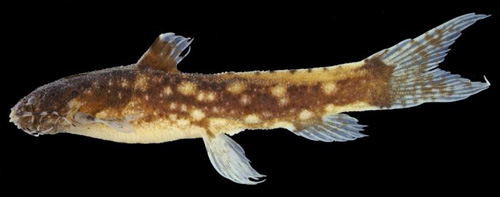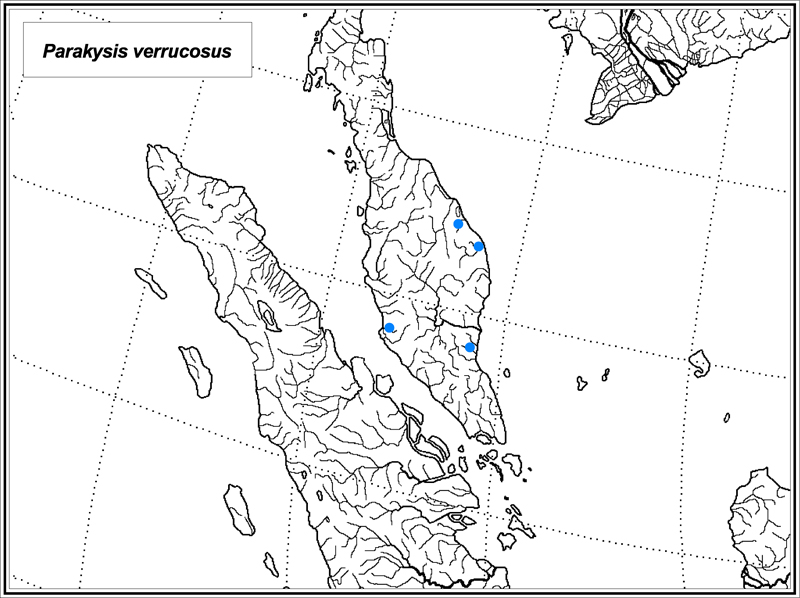
Parakysis verrucosus Herre 1940
Identification: P. verrucosus has a narrow head with small, subcutaneous eyes. The upper lip has a median lobe projecting into a median concavity on the lower lip. There are 1-2 branches on the outer mandibular barbel. The inner mandibular barbel has 2-3 long, thin branches; the first 2 are almost always joined at the base. The mandibular latero-sensory canal has a pore lateral to the inner and outer mandibular barbels. Body tubercles are small. The dorsal fin has 1 spine and 4 rays; the first 2-3 rays are simple, the last 1-2 rays are branched. The pectoral fin has 1 spine and 5-6 rays; the innermost ray is sometimes branched; the 4-5 median rays are branched, and the outermost ray is sometimes simple. The pelvic fin has 5-6 rays; the first ray is simple, the 3-4 median rays are branched, and the last 2 rays are simple. The anal fin has 8-10 rays; the first 5-6 rays are simple, the last 2-5 rays are branched. The caudal fin has 12-13 rays; the uppermost and lowermost principal rays are simple, the 10-11 median rays are branched. The caudal fin has pointed lobes and lacks secondary branching of the rays. There are 30-33 total vertebrae, 18-20 preanal vertebrae, and 10-13 postanal vertebrae. The body is light brown, usually without prominent saddles. The caudal fin has little dark pigment and mottling. Maximum size = 32 mm SL.
Range: P. verrucosus is found in Peninsular Malaysia and the Riau Archipelago.
Habitat: P. verrucosus is found in swampy areas of streams.
Similar species: P. verrucosus has a less darkly pigmented caudal fin than other members of the genus and usually has a lighter, more uniform body color than does P. grandis and P. longirostris, which have more prominent dorsal saddles. P. anomalopteryx lacks a lobe on the upper lip and corresponding median concavity on the lower lip, lacks branching of the outer mandibular barbel, and has lighter sides and belly. P. grandis has secondary branching of the caudal fin rays in specimens larger than 30 mm SL. P. grandis and P. longirostris have short, thick branches on the inner mandibular barbel that are not joined at the base.
Information from:
Ng, H. H. and K. K. P. Lim. 1995. A revision of the southeast Asian catfish genus Parakysis (Teleostei: Akysidae), with descriptions of two new species. Ichthyological Exploration of Freshwaters 6 (3): 255-266.
Ng, H. H. and M. Kottelat. 2003. Parakysis notialis, a new species of akysid catfish from Borneo (Siluriformes: Akysidae). Ichthyological Research 50: 48-51.
